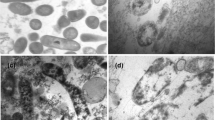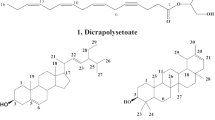Abstract
Previous studies carried out in our laboratory described the antimicrobial activity of the whole hexanic extract (HE) of Achyrocline satureioides (Lam.) DC against Paenibacillus larvae, the causal agent of American Foulbrood (AFB) a disease of the honey bee larvae. In this study, the HE was partitioned into five main fractions by chromatographic techniques leading to the isolation of four known compounds: two prenylated phloroglucinol α-pyrones (1 and 3), 5,7-dihydroxy-3,8-dimethoxyflavone (gnaphaliin A) (2), and 23-methyl-6-O-demethylauricepyrone (4). Isolated compounds were further analyzed towards structural elucidation using 1H RMN and 13C RMN spectroscopic techniques. For the first time, the antimicrobial activity of the isolated compounds was evaluated against P. larvae strains by broth microdilution method and compared with that of the whole HE. Compounds 1–4 displayed minimum inhibitory concentration (MIC) and minimum bactericidal concentration (MBC) values ranging between 0.07 and 62.5 μg/mL and 0.26 and 12.5 μg/mL, respectively. The lowest MIC and MBC values were obtained with compounds 3 and 4, respectively. The antimicrobial activity of each single compound and the combination of them showed that the presence of all compounds is needed for the antimicrobial efficacy of whole HE.


Similar content being viewed by others
Data availability
Not applicable.
References
Genersh E (2010) American foulbrood in honeybees and its causative agent. Paenibacillus larvae J Invertebr Pathol 103:S10–S19
Lindström A, Fries I (2015) Sampling of adult bees for detection of American foulbrood (Paenibacillus larvae subsp. larvae) spores in honey bee (Apis mellifera) colonies. J Apic Res 44(2):82–86
Se recuerda que no está permitido el uso de antibióticos en las colmenas. Available from: www.senasa.gob.ar. Accessed July 3, 2021.
Evans JD (2003) Diverse origins of tetracycline resistance in the honey bee bacterial pathogen. Paenibacillus larvae J Invertebr Pathol 83:46–50
Alippi AM, López AC, Reynaldi FJ, Grasso DH, Aguilar OM (2007) Evidence for plasmidmediated tetracycline resistance in Paenibacillus larvae, the causal agent of American Foulbrood (AFB) disease in honeybees. Vet Microbiol 125:290–303
Reybroeck W, Daeseleire E, De Brabander HF, Herman L (2012) Antimicrobials in beekeeping. Vet Microbiol 158:1–11
López Uribe, M, Underwood, R (2019) Honey bee diseases: American Foulbrood. College of Agricultural Sciences. The Pennsylvania State University 323 Agricultural Administration Building University Park, PA 16802.
Nascimento GGF, Locatelli J, Freitas PC, Silva GL (2000) Antibacterial activity of plant extracts and phytochemicals on antibiotic resistant bacteria. Braz J Microbiol 31:247–256
Ghosh A, Kanti Das B, Roy A, Mandal B, Chandra G (2008) Antibacterial activity of some medicinal plant extracts. J Nat Med 62:259–262
Flesar J, Havlik J, Kloucek P, Rada V, Titera D, Bednar M, Stropnicky M, Kokoska L (2010) In vitro growth-inhibitory effect of plant-derived extracts and compounds against Paenibacillus larvae and their acute oral toxicity to adult honey bees. Vet Microbiol 145:129–133
Damiani N, Gende LB, Maggi MD, Palacios S, Marcangeli JA, Eguaras MJ (2011) Repellent and acaricidal effects of botanical extracts on Varroa destructor. Parasitol Res 108:79–86
Joray M, del Rollán M, Ruiz G, Palacios S, Carpinella M (2011) Antibacterial activity of extracts from plants of Central Argentina—isolation of an active principle from Achyrocline satureioides. Planta Med 77(01):95–100
Albo GN, Henning C, Ringuelet JA, Reynaldi FJ, De Giusti MR, Alippi AM (2003) Evaluation of some essential oils for the control and prevention of American Foulbrood disease in honey bees. Apidologie 34:417–437
Fuselli SR, Garcia de la Rosa S, Gende LB, Eguaras MJ, Fritz R (2006) Antimicrobial activity of some Argentinean wild plant essential oils against Paenibacillus larvae, causal agent of American Foulbrood (AFB). J Apic Res 45:2–7
Gende LB, Bailac P, Maggi MD, Ponzi M, Fritz R, Eguaras MJ (2009) Antimicrobial activity of Pimpinella anisum and Foeniculum vulgare essential oils against Paenibacillus larvae. J Essent Oil Res 21:91–93
Santos RCV, Alves dos Santos CF, Schneider T, Lopes LQS, Aurich C, Giongo JL, Brandelli A, de Almeida Vaucher R (2012) Antimicrobial activity of Amazonian oils against Paenibacillus species. J Invertebr Pathol 109:265–268
Antúnez K, Harriet J, Gende L, Maggi M, Eguaras M, Zunino P (2008) Efficacy of natural propolis extract in the control of American Foulbrood. Vet Microbiol 131:324–331
Mărghitaş L, Dezmirean D, Chirilă F, Fiţ N, Bobiş O (2011) Antibacterial activity of different plant extracts and phenolic phytochemicals tested on Paenibacillus Larvae Bacteria. J Anim Sci Biotechno 44(2):94–99
Isidorov VA, Buczek K, Segiet A, Zambrowski G, Swiecicka I (2018) Activity of selected plant extracts against honey bee pathogen Paenibacillus larvae. Apidologie 49:687–704
Casero C, Machín F, Méndez-Álvarez S, Demo M, Ravelo AG, Pérez-Hernández N, Joseph-Nathan P, Estévez-Braun A (2015) Structure and antimicrobial activity of phloroglucinol derivatives from Achyrocline satureioides. J Nat Prod 78(1):93–102
Lorenzo D, Tai-Seraffini L, Santos AC, Frizzo CD (2000) Achyrocline satureioides essential oils from Southern Brazil and Uruguay. Planta Med 66:476–477
De Souza KCB, Bassani VL, Schapoval EES (2007) Influence of excipients and technological process on anti-inflammatory activity of quercetin and Achyrocline satureioides (Lam.) D.C. extracts by oral route. Phytomedicine 14:102–108
. Davies, Ph, Villamil, JJ (2004) Estudios en domesticación y cultivo de especies medicinales y aromáticas nativas. Serie FPTA-INIA Nº 11.
Giangulani RN (1976) Las especies argentinas del género Achyrocline (Compositae). Darwiniana 20:549–576
Retta D, Dellacassa E, Villamil J, Suárez SA, Bandoni AL (2012) Marcela, a promising medicinal and aromatic plant from Latin America: A review Ind. Crop Prod 38:27–38
Garcia D, Furlan MR, Diamante MS, Minatel IO, Borges CV, Wu Y, Pereira Lima GP, Ming LC (2019) Promising phytochemical responses of Achyrocline satureioides (Lam.) DC. under various farming conditions Ind. Crop Prod 129:440–447
Rivera F, Gervaz E, Sere C, Dajas FJ (2014) Toxicological studies of the aqueous extract from Achyrocline satureioides (Lam.) DC (Marcela). J Ethnopharmacol 95:359–362
González MJ, Marioli JM (2010) Antibacterial activity of water extracts and essential oils of various aromatic plants against Paenibacillus larvae, the causative agent of American Foulbrood. J Invertebr Pathol 104:209–213
González MJ, Beoletto VG, Agnese AM, Audisio M, Marioli JM (2015) Purification of substances from Achyrocline satureioides with inhibitory activity against Paenibacillus larvae, the Causal Agent of American Foulbrood in Honeybees’Larvae. Appl Biochem Biotechnol 175:3349–3359
Gende LB, Floris I, Fritz R, Eguaras MJ (2008) Antimicrobial activity of cinnamon (Cinnamonum zeylanicum) essential oil and its main components against Paenibacillus larvae from Argentina. Bull Insectology 61(1):1–4
Gende LB, Fernández N, Buffa F, Ruiu L, Satta A, Fritz R, Eguaras MJ, Floris I (2010) Susceptibility of Paenibacillus larvae isolates to a tetracycline hydrochloride and cinnamon (Cinnamomum zeylanicum) essential oil mixture. Bull Insectology 63:247–250
Reynaldi FJ, Rule R, Arauz S, Alippi AM (2010) Sensibilidad in vitro de Paenibacillus larvae frente a los antibióticos oxitetraciclina, tilosina, tilmicosina y lincomicina. Analecta Vet 30:25–29
Egbuna, C, Ifemeje, JC, Ma duako, MC, Tijjani, H, Udedi, SC, Nwaka, AC, Ifemeje, MO (2019), in Phytochemistry: Fundamentals, Modern Techniques, and Applications, vol 1: Phytochemical test methods: Qualitative, Quantitative and Proximate Analysis (Egbuna, C., Ifemeje, J.C., Udedi, S.C., Kumar, S., ed), Apple Academic Press, Canada, pp 381–426.
Iyengar MA (1995) Study of Crude Drugs, 8th edn. Manipal Power Press, Manipal, India, p p2
Alippi, AM (1990). Técnicas de laboratorio para el aislamiento e identificación de Bacillus larvae White, agente causal de la Loque Americana. Buenos Aires: Comisión de Investigaciones Científicas, Serie difusión, año 2, N° 6.
Lennette, S, Balows, R, Hansler, L, Shadony, E (1987) Manual de Microbiología Clínica. Ed. Panamericana, Buenos Aires, Argentina, pp. 244.
Mann CM, Markham JL (1998) A new method for determining the minimum inhibitory concentration of essential oils. J Appl Microbiol 84:538–544
Cugnata NM, Guaspari E, Pellegrini MC, Fuselli SR, Alonso-Salces RM (2017) Optimal concentration of organic solvents to be used in the broth microdilution method to determine the antimicrobial activity of natural products against Paenibacillus Larvae. J Apic Sci 61(1):37–53
García Damiano MC (1991) Normas de estudios clínicos de antimicrobianos (Parte II). Enfermedades Infecciosas Microbiología Clínica 3(3):17–28
Finelgold, S, Baron, E, Braily, S (1992) Diagnóstico microbiológico, aislamiento e identificación de microorganismos patógenos. Ed. Médica Panamericana, Bs. As., 36, 514- 533.
Fratini F, Mancini S, Turchi B, Friscia E, Pistelli L, Giusti G, Cerri D (2017) A novel interpretation of the fractional inhibitory concentration index: the case Origanum vulgare L. and Leptospermum scoparium J. R. et G. Forst essential oils against Staphylococcus aureus strains. Microbiol Res 195:11–17. https://doi.org/10.1016/j.micres.2016.11.005
Sabate DC, Gonzalez MJ, Porrini MP, Eguaras MJ, Audisio MC, Marioli JM (2012) Synergistic effect of surfactin from Bacillus subtilis C4 and Achyrocline satureioides extracts on the viability of Paenibacillus larvae World. J Microbiol Biotechnol 28:1415–1422
Rodríguez-Ramos F, Navarrete A (2009) Solving the confusion of gnaphaliin structure: gnaphaliin A and gnaphaliin B identified as active principles of Gnaphalium liebmannii with tracheal smooth muscle relaxant Properties. J Nat Prod 72:1061–1064
Kuete V (2010) Potential of Cameroonian plants and derived products against microbial infections: a review. Planta Med 76(14):1479–2149
Pimentel-Betancurt DC, Tonello NV, Padilla-Alvarez F, Paletti-Rovey MF, Oliva MM, Marioli JM (2021) Oral and contact toxicity of the extract obtained with hexane from Achyrocline satureioides on larvae and adult honey bees. Span J Agric Res 19(3):1–9
Harris R (2002) Synergism in the essential oil world. Int J Aromather 12(4):179–186
Wagner H, Ulrich-Merzenich G (2009) Synergy research: approaching a new generation of phytopharmaceuticals. Phytomedicine 16(2–3):97–110. https://doi.org/10.1016/j.phymed.2008.12.018
Tallarida R (2001) Drug Synergism: Its Detection and Applications. J Pharmacol Exp Ther 298(3):865–872
Delaquis PJ, Stanich K, Girard B, Mazza G (2002) Antimicrobial activity of individual and mixed fractions of dill, cilantro, coriander and eucalyptus essential oils. Int J Food Microbiol 74:101–109
Funding
This study was financially supported by Agencia Nacional de Promoción Científica and Secretaría de Ciencia y Técnica from the Universidad Nacional de Río Cuarto.
Author information
Authors and Affiliations
Contributions
Each author has contributed significantly to this work. NT performed the experiments and analyzed the data, DP and CH performed the experiments, JM designed the experiments, MM supervised the experiments, MO supervised the experiments and edited the manuscript, and FD wrote the manuscript and edited the manuscript. All authors have reviewed, discussed, edited, and approved the final manuscript.
Corresponding author
Ethics declarations
Ethics approval
This article does not contain any studies with human participants or animals performed by any of the authors.
Consent to participate
The authors consented to participate the current research.
Consent for publication
The authors approved the manuscript and agree to publish it in current form in Brazilian Journal of Microbiology.
Competing interests
The authors declare no competing interests.
Additional information
Responsible Editor: Lucy Seldin
Publisher's note
Springer Nature remains neutral with regard to jurisdictional claims in published maps and institutional affiliations.
Rights and permissions
About this article
Cite this article
Tonello, N., Pimentel Betancurt, D., Huallpa, C.L. et al. Fractionation of hexane extracts from Achyrocline satureioides and their biological activities against Paenibacillus larvae. Braz J Microbiol 53, 1645–1655 (2022). https://doi.org/10.1007/s42770-022-00736-y
Received:
Accepted:
Published:
Issue Date:
DOI: https://doi.org/10.1007/s42770-022-00736-y




